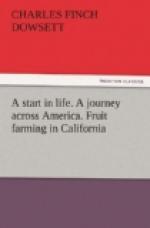Having run through Illinois, Iowa, and Nebraska, we commence the State of Wyoming as we pull up at the City of Cheyenne, where, in the far distance, we see, with its peaks well clothed in snow, the grand range of the Rocky Mountains. Soon after leaving Cheyenne, we commence the ascent of the Rockies—not, of course, the actual summit range itself, but the foot hills and high lands stretching away from, and forming part of it—and as we climb the ascent terminating at Sherman, where we have gained an elevation of 8,247 feet, we pass through very wild, grand scenery. At this altitude we look down upon floating clouds, and see in the distance Long’s Peak, 14,000 feet high, towering above them. All along, at intervals, are portable fences, placed to catch the snow as it drifts, to prevent it blocking the line; and also what are called snow sheds, which are rough timber tunnels built up to protect the rails from the great drifts arising out of heavy snowstorms. At the highest point is a pyramid, commemorating a certain Mr. Oakes Ames, which looked 20 feet high and very near the line; it is however, 75 feet high and half-a-mile off. The air is so rarefied that distances are most deceiving.
As our descent proceeds, we catch sight, in the distance, of a herd of wild elk, and where these rolling prairies have better herbage, we see herds of horses with ranch buildings here and there. We pass the ranch of William Cody, who, by virtue of his being a Senator of the State of Nebraska, is called Honourable, but who was known in London, a short time ago, at Mr. Whitley’s “Wild West” show as “Buffalo Bill.” As we pass Fort Laraime, one of the forts erected by the United States Government as a protection against the Indians, I was told some stories of Cody’s exploits against the Indians. In former days, emigrants traversing these great prairies to found a home in this Wild West, were often harassed by Indians, and the soldiers at the fort had to protect them. Buffalo Bill has been in many a skirmish, and, if rumour is true, many redskins have succumbed to him; the Government took counsel with him in all




